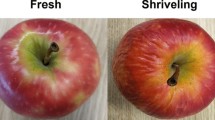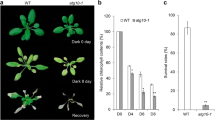Summary
Tomato seedlings were exposed to 3 days of chilling at 5 °C in both the presence and absence of 5 mM ethanolamine. An array of pathological responses could be seen at both the light and electron microscope levels: apparent loss of cell turgor, vacuolization, reduction in the apparent volume of both the cytoplasm and the vacuolar protein bodies, apparent deposition of new material in the cell walls, general disorganization of organelles, especially plastids, and a general loss of cytoplasmic structure. Chilling injury was less pronounced in ethanolamine-treated cotyledonary tissues which appeared to have normal turgor and cell shape at the light microscope level and better preserved organelles at the ultrastructural level. Protection by ethanolamine at the ultrastructural level was most pronounced for the cytoplasm, the mitochondria, and the cell walls. Dead cells were seen with both treatments but were 2–3 times as numerous in the chilled-only tissue.
Similar content being viewed by others
References
Busch, H., 1974: The cell nucleus. Vol. 1. London-New York: Academic Press.
Butler, R. D., andE. W. Simon, 1971: Ultrastructural aspects of senescence in plants. In: Advances in gerontological research (B. L. Strehler, ed.). London-New York: Academic Press.
Guinn, G., 1971: Chilling injury in cotton seedlings: Changes in permeability of cotyledons. Crop Sci.11, 1-1–-1-2.
Hochachta, P. W., 1973: Basic strategies and mechanisms of enzyme adaptation to temperature. In: Effects of temperature on ectothermic organisms (W. Wieser, ed.). Berlin-Heidelberg-New York: Springer.
Jacks, T. J., L. Y. Yatsu, andA. M. Altshul, 1967: Isolation and characterization of spherosomes. Plant Physiol.42, 585–597.
Jones, L. G., and R. D.Cobb, 1963: A technique for increasing the speed of laboratory germination testing. Proceedings 53rd Annual Meeting, Association of official seed analysts. pp. 144–159.
Levitt, J., 1972: Responses of plants to environmental stresses. Chapter 4, “Chilling injury and resistance.” London-New York: Academic Press.
Liebermann, M., C. C. Craft, W. V. Audia, andM. S. Wilcox, 1958: Biochemical studies of chilling injury in sweet potatoes. Plant Physiol.33, 307–311.
Lin, J., T. L. Rost, andC. Elmore, 1974: Light microscopic staining and histochemical applications for plant meristems embedded in Spurr's medium. Mikroskopie30, 281–286.
Lyons, J. M., 1973: Chilling injury in plants. Ann. Rev. Plant Physiol.24, 445–466.
Platt-Aloia, K. A., andW. W. Thomson, 1976: An ultrastructural study of two forms of chilling-induced injury to the rind of grapefruit (Citrus paradisi, Mac. Fed.). Cryobiol.13, 95–106.
Platt, K. A., 1974: An ultrastructural study of two forms of chilling induced injury to the rind of grapefruit (Citrus paradisi, Mac. Fed.). Master's thesis, University of California, Riverside.
Pobielkowska, M., andA. Kazpasska-Palacz, 1971: Effects of Phosphon-D and of low temperature on the morphology of cell protoplasts. Protoplasma73, 469–474.
Sheetz, M. P., andS. J. Singer, 1974: Biological membranes as bilayer couples. A molecular mechanism of drug-erythrocyte interactions. Proc. nat. Acad. Sci. (U.S.A.)71, 4457–4461.
St. John, J. B., andM. B. Christiansen, 1976: Inhibition of linoleic acid synthesis and modification of chilling resistance in cotton seedlings. Plant Physiol.57, 257–259.
Spurr, A. R., 1969: A low-viscosity epoxy embedding medium for electron microscopy. J. Ultrastruct. Res.26, 31–43.
Taylor, A. O., andA. S. Craig, 1971: Plants under climatic stress. II. Low temperature, high light effects on chloroplast ultrastructure. Plant Physiol.47, 719–725.
Trump, B. F., B. P. Croker, Jr., andW. J. Mergner, 1971: The role of energy metabolism, ion, and water shifts in the pathogenesis of cell injury. In: Cell membranes (G. W. Richter andD. G. Scaprelli, eds.). Baltimore: The Williams and Wilkins Co.
Waring, A. J., J. M. Lyons, andR. W. Breidenbach, 1976:In vivo modification of membrane phospholipids in tomato seedlings. Biochim. biophys. Acta443, 157–168.
Wheaton, T. A., 1963: Physiological comparison of plants sensitive and insensitive to chilling temperatures. Ph.D. Thesis. University of California, Davis.
Author information
Authors and Affiliations
Rights and permissions
About this article
Cite this article
Ilker, R., Waring, A.J., Lyons, J.M. et al. The cytological responses of tomato-seedling cotyledons to chilling and the influence of membrane modifications upon these responses. Protoplasma 90, 229–252 (1976). https://doi.org/10.1007/BF01275677
Received:
Issue Date:
DOI: https://doi.org/10.1007/BF01275677




